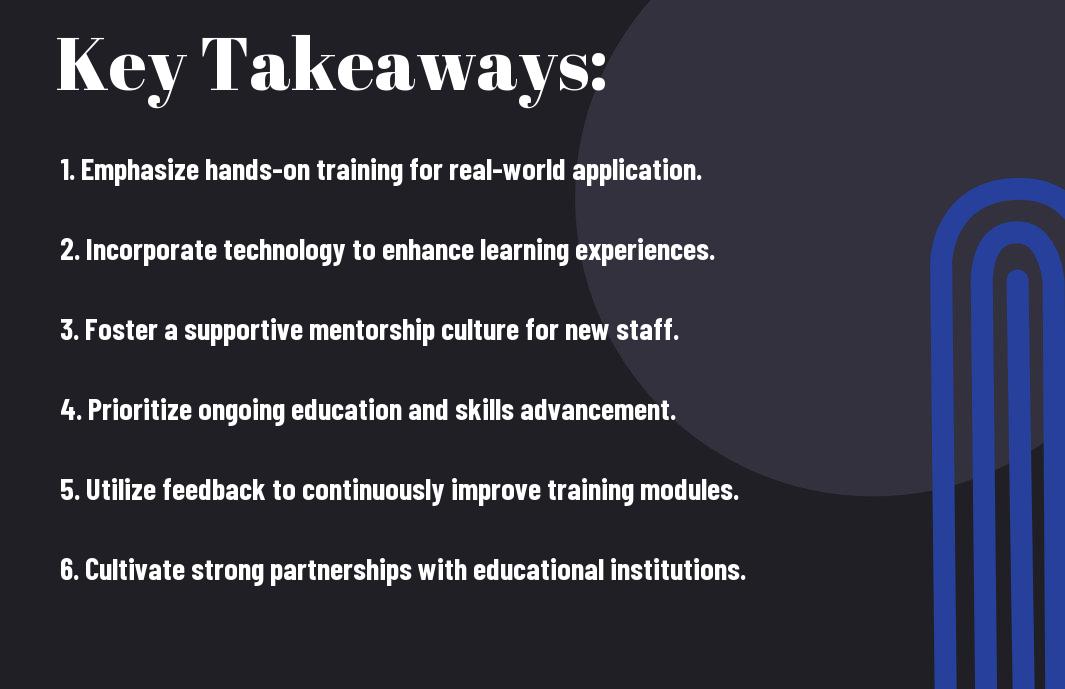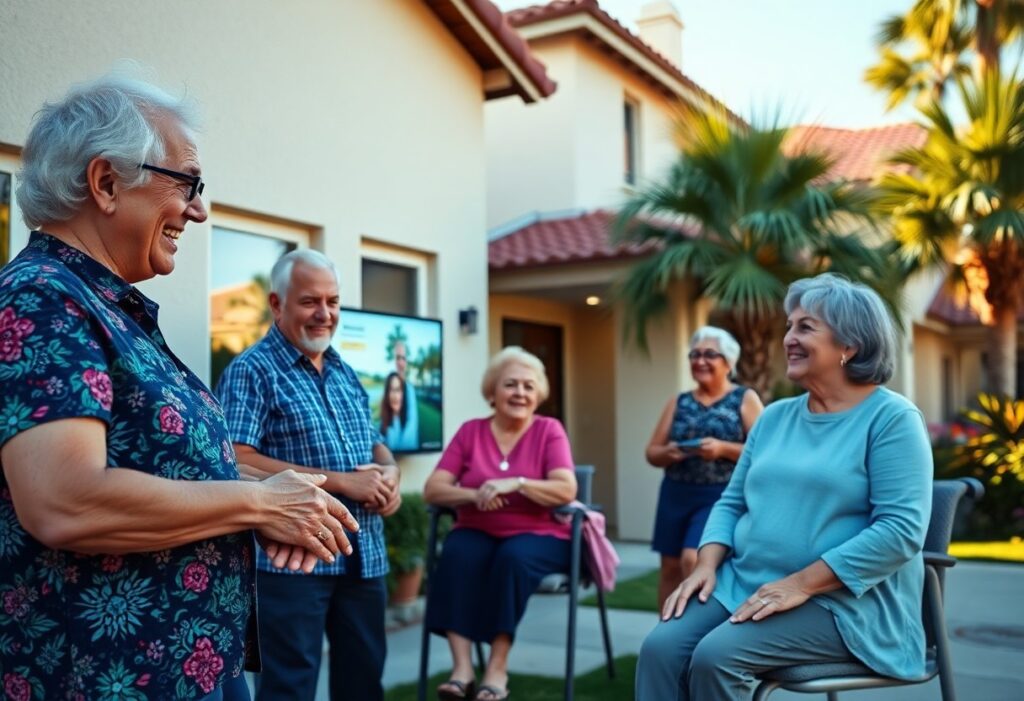Many individuals in the senior care sector are recognizing the importance of investing in skilled workforce development. As you navigate the complexities of providing quality care, implementing next-generation training programs can significantly enhance your team’s effectiveness and adaptability. By embracing innovative educational strategies, you have the opportunity to improve both staff morale and patient outcomes, creating a safer and more supportive environment for seniors. This post will guide you through important practices for mastering workforce development in senior care.
Key Takeaways:
- Next-generation training programs focus on integrating technology and innovative teaching methods to enhance learning outcomes for senior care staff.
- Collaboration with industry experts and organizations helps to ensure training content remains relevant and addresses the evolving needs of the senior care sector.
- Emphasis on soft skills development, such as communication and empathy, is important to improving the quality of care provided to seniors.

Understanding Workforce Development
Before stepping into effective training programs, it’s vital to grasp the concept of workforce development. This process involves strategically enhancing the skills and capabilities of individuals within your organization to meet the growing demands of the senior care industry. By fostering continuous education and development, you can build a competent workforce that not only excels in delivering care but also adapts to evolving industry standards.
Importance of Skilled Workforce in Senior Care
The significance of a skilled workforce in senior care cannot be overstated. As the population ages, the demand for qualified caregivers intensifies. A proficient team enhances the quality of care, promotes positive patient outcomes, and instills trust within families. Moreover, investing in skill development leads to employee retention, reducing turnover rates and creating a stable, compassionate environment for seniors.
Challenges in Current Training Programs
Senior care facilities face numerous obstacles in current training programs. Despite the increasing demand for skilled staff, many organizations struggle with inadequate resources, outdated training materials, and high turnover rates that disrupt continuity in education. Additionally, limited access to comprehensive training opportunities hampers caregivers’ ability to acquire vital skills, ultimately impacting the quality of care provided.
Care providers must also grapple with competing priorities, often leading to insufficient time dedicated to training. This translates to a workforce that may not be fully equipped to handle diverse patient needs effectively. The challenge of keeping up with the healthcare sector’s fast-paced evolution further complicates matters, hindering your staff from accessing cutting-edge techniques and knowledge. Addressing these issues is vital for enhancing the competency of your team and ensuring the best possible care for your clients.
Next-Generation Training Approaches
One innovative shift in workforce development is the adoption of next-generation training approaches that cater to the unique demands of senior care. By focusing on enhanced hands-on experiences and interactive learning scenarios, these methods prepare you and your team for real-world challenges in a way that traditional training often falls short.
Innovative Learning Techniques
Training methods are evolving to include gamification, simulations, and collaborative learning environments. These innovative techniques engage you actively, making the educational process more relatable and effective. By participating in practical, scenario-based exercises, you can better grasp the complexities of senior care and develop vital interpersonal skills.
Integration of Technology in Training
For a comprehensive learning experience, integrating technology into your training programs can enhance both knowledge retention and skill acquisition. By utilizing virtual reality, mobile applications, and e-learning platforms, you can access training materials and resources anytime, anywhere.
A blend of technology and training offers significant advantages in senior care education. With tools like virtual reality simulations, you can immerse yourself in realistic scenarios that challenge your decision-making skills. Additionally, mobile applications enable you to learn at your own pace, ensuring that you grasp vital concepts before progressing. This integration also facilitates remote training, allowing your staff to receive education without needing to be on-site, ultimately enhancing your team’s flexibility and responsiveness in a fast-paced environment.

Role of Mentorship and Peer Support
All successful workforce development initiatives in senior care leverage the power of mentorship and peer support. By fostering relationships between seasoned professionals and newcomers, you create an environment where knowledge is transferred seamlessly, enhancing both individual growth and team cohesion. This supportive framework not only boosts confidence but also equips you with necessary skills for addressing the unique challenges in senior care, ultimately improving the quality of care delivered.
Building a Supportive Community
For anyone entering the senior care field, establishing a supportive community is necessary. By engaging with fellow staff members and mentors, you can share experiences, seek advice, and cultivate a sense of belonging that helps you thrive in your role. This network can be a valuable resource, offering encouragement and guidance that fosters personal and professional growth.
Impact of Experienced Professionals
Before delving into the nuances of senior care, you must recognize the impact that experienced professionals have on your development and workplace culture. Their insights inform best practices and set a standard for excellence, making your learning curve less daunting as you navigate the complexities of the industry.
It is through observing experienced professionals that you can grasp the nuances and subtleties of patient care that textbooks may overlook. Guidance from seasoned mentors helps you avoid common pitfalls, reducing the likelihood of errors that could compromise care quality. Additionally, their ability to share real-world scenarios enriches your understanding and prepares you for challenges that may arise on the job. By valuing the insights of experienced individuals, you not only improve your skills but also contribute to a culture of excellence in your workplace.
Assessing Training Effectiveness
Once again, evaluating your training programs is important for ensuring that they are meeting the needs of both your staff and the senior care residents they serve. By implementing systematic assessments, you can identify strengths and areas for improvement, aligning your program with best practices in the industry. This creates a cycle of feedback that drives better outcomes for both employees and those in their care.
Metrics for Success
Effectiveness can be measured through various metrics such as employee retention rates, skill competency assessments, and resident satisfaction scores. By tracking these indicators, you can gain valuable insights into how well your training initiatives are performing and where adjustments may be necessary.
Continuous Improvement Strategies
Before you finalize any training program, consider implementing ongoing evaluation processes that allow you to adapt and refine your approach based on feedback. This will ensure your programs remain relevant and effective.
Further, establishing feedback loops with trainers and trainees can significantly enhance your training’s impact. Conduct regular surveys and focus groups to assess the training experience, and be open to making changes based on employee input and performance data. Focus on identifying skill gaps and addressing them promptly, along with tailoring future programs to better align with your team’s evolving needs. Integrating these continuous improvement strategies not only keeps your training initiatives fresh but also helps maintain a motivated and well-prepared workforce capable of delivering excellent senior care.
Case Studies in Senior Care Training
Unlike many training approaches, successful workforce development in senior care relies heavily on evidence-based case studies that demonstrate tangible results. Here are several key examples:
- Provider A: Increased staff retention by 30% through a mentorship program.
- Provider B: Improved patient satisfaction scores from 75% to 90% after implementing a continuous education initiative.
- Provider C: Reduced emergency room visits by 25% via enhanced caregiver training in chronic disease management.
- Provider D: Achieved a 40% reduction in staff turnover through specialized leadership training for all mid-level managers.
Successful Models from Leading Organizations
The evidence indicates that the best training programs are often holistic, blending hands-on experience with theoretical knowledge. Programs developed by leading organizations have showcased enhanced competency in caregiving staff, transitioning their service quality and operational efficiency significantly upward.
Lessons Learned from Implementation
Organizations often face challenges when implementing new training models; however, valuable insights can be gleaned from those experiences. Commitment to training cannot be an afterthought; you need to integrate it into your organizational culture. Additionally, periodic assessments are needed to address gaps and adapt effectively. Engaging staff in feedback loops can also enhance training relevance and encourage participation, ultimately leading to a more competent workforce.
From numerous implementations, it is clear that prioritizing staff involvement in the training process is vital. This approach not only fosters a sense of ownership but also ensures alignment with actual workplace needs. Training tailored to staff feedback often leads to higher enrollment and retention rates. Furthermore, inadequate support from leadership can lead to program failure, as enthusiastic participation dwindles without proper backing. Focusing on a structured, data-driven approach to training will cultivate a skilled workforce that enriches the quality of senior care.
Future Trends in Senior Care Workforce Development
Not only is the landscape of senior care evolving, but it also demands innovative approaches to workforce development. As the demographic of seniors diversifies, there is an increased need for skilled professionals equipped to address the unique challenges that arise. Embracing technology, enhancing training programs, and implementing adaptable strategies will be key to fostering a resilient and effective workforce in the years ahead.
Predictions for Evolving Needs
By analyzing current trends, it becomes evident that the demand for specialized skills in geriatric care and mental health support will rise significantly. You will see a shift towards interdisciplinary training that combines technical expertise with emotional intelligence, reflecting the growing recognition of holistic care methods.
Strategies for Adapting to Change
Adapting to the shifts in senior care will involve a continuous commitment to lifelong learning and professional development. You should invest in flexible training modules that can be tailored to meet the evolving regulations and practices in the industry.
Due to the rapid advancements in technology and the constantly changing needs of senior populations, your organization must be proactive in its workforce strategies. Establishing partnerships with educational institutions can foster a pipeline of fresh talent, while integrating virtual training environments will enable staff to gain experience without the constraints of traditional settings. Focusing on employee well-being and retention strategies will be vital to create a supportive workplace culture that attracts and maintains skilled professionals, ultimately ensuring that you can deliver the highest level of care to seniors.

Summing up
On the whole, mastering workforce development through next-generation training programs for senior care is necessary for enhancing your skills and ensuring quality care for older adults. By focusing on innovative training methods, you can meet the evolving demands of the workforce. Utilize resources such as the Master Plan for Aging Work Opportunity to stay informed and prepared as you navigate this impactful field. Invest in your growth to build a resilient workforce dedicated to excellence in senior care.
FAQ
Q: What are the key features of next-generation training programs for senior care?
A: Next-generation training programs for senior care focus on several key features to enhance the learning experience and improve care outcomes. These include the integration of technology using virtual reality (VR) and augmented reality (AR) for immersive learning, personalized learning paths that cater to the individual needs and learning styles of employees, and competency-based assessments that ensure staff members meet the required skill levels. Additionally, these programs emphasize soft skills development such as empathy and communication, which are important in providing high-quality senior care.
Q: How can organizations effectively implement these training programs for their workforce?
A: Organizations looking to implement next-generation training programs should start by conducting a thorough assessment of their current training processes and identifying gaps in employee skills. Afterward, they can explore partnerships with education technology providers to acquire the necessary resources and platforms. It’s vital to involve frontline staff in the development of the training content to ensure it meets their real-world challenges. Moreover, organizations should establish a culture of continuous learning by encouraging feedback, providing ongoing support, and regularly updating training materials to keep up with the latest industry standards and practices.
Q: What benefits do advanced training programs bring to senior care facilities?
A: Advanced training programs offer numerous benefits to senior care facilities, including improved staff retention rates due to enhanced job satisfaction and professional growth opportunities. They also lead to improved quality of care, as employees become better equipped to handle the complexities of senior needs. Furthermore, investments in training can significantly reduce compliance issues and liability risks, as staff are well-trained in regulatory requirements and best practices. Overall, these programs contribute to a more skilled, confident workforce that can provide high-quality services to seniors, translating into better overall care outcomes.







